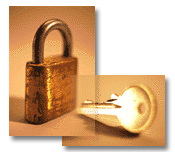This program accepts a key and a stream of text and operates on it using the ARCFOUR
(unofficial implementation of RC4) stream cipher
as implemented in our project. The encrypted form of a message generally contains some non-text
characters that possibly won't be handled correctly by the web browser. Therefore, the encrypted
form can be represented in either hexadecimal digits or in Base64 encoding.
This application is a demonstration only; using it on a remote server will allow your message
to travel over public channels in the clear!
#;
}
# Print an error
if($error ne '') {
print "";
# Provide a form
print $cgi->start_form(-method=>'post',-action=>'stream.cgi');
print "
";
print $cgi->textfield(-name=>'key',-value=>"This key may be any random string of characters.",
-maxLength=>256, -class=>"rightPartInput");
print "
$break
\n";
print "
";
print $cgi->textarea(-name=>'message',-value=>"Enter the message (plaintext or ciphertext) here.",
-class=>'rightPartInput',-rows=>10,-cols=>80);
print "
$break
\n";
{
my @radios = $cgi->radio_group(-name => 'encoding',
-values => [qw/Hexadecimal Base64/],
-default => 'Hexadecimal'
);
$_ = "
$_
" foreach @radios;
print "
\n";
}
print "
";
print $cgi->submit(-name=>'encryptSubmit',-value=>"Encrypt",-class=>'submitButton');
print $cgi->submit(-name=>'decryptSubmit',-value=>"Decrypt",-class=>'submitButton');
print "
";
$_ = $cgi->end_form;
s!(
)!$1
!sg;
print $_;
print "
